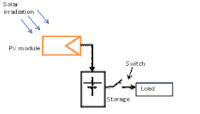SOLAR PHOTOVOLTAIC ARRAY – STORAGE COMBINATION OPTIMIZATION FOR STAND-ALONE SYSTEMS
Keywords:
Storage Capacity (CS), Array Capacity(CA), State of Charge (SOC), Loss of Load Probability (LOLP), Photovoltaic (PV)Abstract
This study presents a method of optimizing photovoltaic array and storage in standalone photovoltaic (PV) system. The configuration consists of two components parameters; arrays capacity and storage/(battery) capacity. By adjusting these two parameters, the reliability of the PV system can be determined. The reliability of the PV system is determined based on the concept of Loss of Load Probability (LOLP) from which the optimum storage and array capacities CS and CA respectively, may be define with respect to the costs per unit energy generated by the PV array and cost per unit energy stored in the storage. The standalone PV system energy was
simulated using data for 21 year for three locations in Nigeria. A numerical method is applied to generate LOLP- array capacity plots for definite storage capacities and iso-reliability plots obtained from these for three locations in Nigeria. The correlation coefficients of iso-reliability lines range from 0.7931 to 0.9967 for the three locations considered. Regression method is applied to the equations for each set of iso-reliability lines to obtain a general equation relating array capacity to storage capacity for each location which is then optimized with respect to cost to obtain an expression for the storage capacity at the lowest system cost.
Downloads
References
Egido M. and Lorenzo E. (1992). “The Sizing of Stand Alone PV Systems: A Review and a Proposed New Method”, Solar Energy Materials and Solar Cells, 26( 1-2): 51-69.
Posadillo R. and Lopez L. R. (2008). “Approaches for Developing a Sizing Method for Stand Alone PV Systems with Variable Demand”, Renewable Energy 33: 1037- 1048.
Khatib T. (2010). “A review of designing, installing and evaluating standalone photovoltaic power systems” J. Applied Sci., 10; 1212-1228.
Semaoui S., Hadj Arab A., Bacha S. and Azoui B. (2013). “Optimal sizing of a stand-alone photovoltaic system with energy management in isolated areas”. Energy Proc; 36; 358–68. http://dx.doi.org/10.1016/j.egypro.
Khatib T., Elmenreich W. and Novel T. (2014). “Simplified hourly energy flow models for photovoltaic power systems”. Energy Convers Manage 79; 441–448. http:// dx.doi.org/10.1016/j.enconman.
Fathi A. E. l., Nkhaili L., Bennouna A. and Outzourhit A. (2014) “Performance parameters of a standalone PV plant”. Energy Convers Manage 2014; 86:490–495. http://dx.doi. org/10.1016/j.enconman.
Erusiafe, Oyebola and Onanuga J. of NAMP Dufo-López R., Lujano-Rojas J. M. and Bernal-Agustín J. L. (2014) “Comparison of different lead – acid battery lifetime prediction models for use in simulation of stand-alone photovoltaic systems”. Appl Energy; 115:242–53. http://dx.doi.org/ 10.1016/j.apenergy.
Illanes R., Francisco A. D., Núñez F., De Blas M., García A. and Luis J. (2014) “Dynamic simulation and modelling of stand-alone PV systems by using state equations and numerical integration methods”. Applied Energy 2014; 135:440–9. http://dx. doi.org/10.1016/j.apenergy.
Lee M., Soto D. and Modi V. (2014) “Cost versus reliability sizing strategy for isolated photovoltaic micro-grids in the developing world”. Renewable Energy 2014; 69:16–24.
Bouabdallah A., Olivier J. C., Bourguet S., Machmoum M. and Schaeffer E. (2015) “Safe sizing methodology applied to a standalone photovoltaic system”. Renewable Energy 2015; 80:266–74. http://dx.doi.org/10.1016/j.renene.
Dorji T., Urmee T. and Jennings P. (2012) “Options for off-grid electrification in the Kingdom of Bhutan”. Renewable Energy; 45:51-80.
Mandelli S., Brivio C., Colombo E. and Merlo M. (2016) “A sizing methodology based on levelized cost of supplied and lost energy for off-grid rural electrification systems loss of load loss of load probability”. Renewable Energy 2016; 89:475–88. http://dx.doi.org/10.1016/j.renene.
Nordin N. D. and Rahman H. A. (2016) “A novel optimization method for designing stand-alone photovoltaic system”. Renewable Energy 2016; 89:706–15. http://dx.doi.org/ 10.1016/j.renene.
Erusiafe N. E. and Chendo M. A. C. (2008). “Life Cycle – Cost Analysis for Stand Alone Photovoltaic System. Application to Ikeja, Nigeria”. Proceedings of the 10th world Renewable Energy Congress, July 19 – 25, 2008. Glasgow, U.K. pp. 1463 – 1468.
Mellita A.,and Benghanem M. (2007). “Sizing of stand-alone photovoltaic systems using neural network adaptive model.” Desalination, 209 (1-3) , pp. 64-72.
Sundén , B. (2019) “Thermal management of batteries” in: Hydrogen, Batteries and Fuel Cells - Academic Press, Copyright © 2019 Elsevier Inc. pp.93-110
Tamer Khatib T., Ibrahim I. A. and Mohamed A. (2016) “A review on sizing methodologies of photovoltaic array and storage battery in a standalone photovoltaic system”. Energy Conversion and Management 120: 430–448

Downloads
Published
Issue
Section
License
Copyright (c) 2023 The Journals of the Nigerian Association of Mathematical Physics

This work is licensed under a Creative Commons Attribution-NonCommercial-ShareAlike 4.0 International License.




